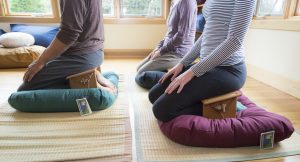This is one of many ways to practice meditation. This is particularly effective in quietening the mind and grounding the body.
Once you have assumed a comfortable sitting position, take the first few moments to sweep through the body with the intention to relax. Soften and let go around areas of tightness and contraction.

Kneeling for meditation on a Peace Bench with Zabuton sitting mats
Let all the senses be awake…aware of physical sensations, mood, sounds and space in all directions.
Then, become aware in a very soft yet clear way of the movement of the breath. Your awareness can rest in the breath wherever the sensations of breathing are most predominant. For most people, this is either the inflow and outflow at the nose, or the rising and falling movement at the chest or abdomen.
 Once you decide where to be with the breath, let this be an anchor, the place you return to again and again. Bring a full mindfulness to the breath: making no effort to control the breath, discover what it is actually like, moment to moment. If the attention gets too tight or tense, relax your body again, soften back into the breath. If the attention becomes spacy, difficult to focus, then intend to bring a real precision and clarity to the awareness of the breath.
Once you decide where to be with the breath, let this be an anchor, the place you return to again and again. Bring a full mindfulness to the breath: making no effort to control the breath, discover what it is actually like, moment to moment. If the attention gets too tight or tense, relax your body again, soften back into the breath. If the attention becomes spacy, difficult to focus, then intend to bring a real precision and clarity to the awareness of the breath.
The purpose of meditation practice is to bring a mindful attention to the changing flow of life, without either clinging to experience or resisting what is happening. Let your attention rest mindfully in the breath.
When a strong emotion or sensation arises let go of the breath as a primary area of attention and open the awareness to include the waves of experience that are arising. Notice what they are like as sensations in the body, feelings in the body/mind…and notice how they change. Let your intention be to neither resist what is painful or grasp at pleasure. Rather, bring an unconditional caring presence that allows life to unfold without interference.

Crescent Zafu/Smile cushion on Zabuton sitting mats
To be truly present means to be aware of thinking, not lost in trains of thought. Typically the mind will contract and move off into thought forms repeatedly. This is natural, and when it occurs, simply recognize that thinking is happening by mentally noting “thinking, thinking”. Without any judgement, open out of thoughts and relax back into the breath. Often our thoughts are repetitive and strongly driven by emotions. When this happens, rather than returning to the breath, recognize and note the thinking and then open the awareness into the body and heart to sense what is asking for attention.
Often there is fear or longing that needs to be included in awareness. Until we touch this directly, the mind will keep contracting off into thought forms and disconnecting from the present moment.
A Few More Tips
For many people, noting or naming what is happening can be helpful in connecting the awareness directly with moment to moment experience. For instance, when a strong sensation arises you might note “tension”, “tightness”, “hot”, “cold”, “pressure”, “ache”, “tingling”…and if there is much pain or pleasure…”unpleasant” or “pleasant”. Similarly emotions can be labeled: “sadness”, “happiness”, “fear”, “grief”, etc. Let the noting be soft and in the background, with most of your attention directly experiencing what is happening.
The quality of care or friendliness (metta) towards our experience is an essential foundation for mindfulness. Kindness allows us to open, de conditioning the tendency of our minds to resist and contract away from life. It is helpful to reflect on the intention of relating to experience in a gentle and kind way at the beginning of each sitting (and day!)
For some people, listening to sounds is a useful alternative to using the breath as an anchor. Open the awareness to include the space within which sounds arise, and listen without controlling anything. Simply let sounds happen, noticing how they arise, change, dissolve. While you may find it valuable to use sounds as an anchor for attention in this way, it is important to also learn to concentrate and develop mindfulness around the breath.
So after the attention has opened and relaxed by resting in the awareness of sounds once again practice by being with the breath.
Remember that we can start our meditation fresh at any moment. Simply take a few conscious breaths, open out of thoughts, relax the body, and come back to rest in the breath or in listening to sounds. We all have preconceived notions and preferences regarding “good meditations”. It helps to recognize that this is a liberating but challenging path: Our nature is to be lost in thought, be reactive to our experience, get restless, sleepy, doubtful…Try not to judge you experience. Rather, trust that you are truly an awakening, loving being. Practice love by accepting whatever arises. Gradually the practice of mindfulness and compassion will free you to express your true nature and live each moment fully. A lotus bud for you!
Thanks to Tara Brach and the Insight Meditation Community of Washington for reprinting this guided meditation. Click here to find out about their weekly sittings in the Washington D.C. area and meditation retreats.
